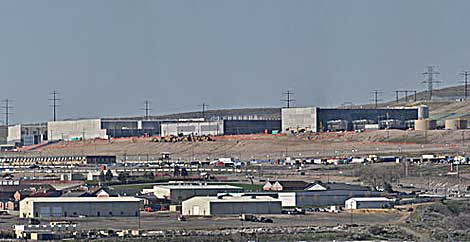NSA Data Center Plagued by Electrical Problems
The NSA's massive data center in Utah has been plagued by electrical problems that have delayed the opening of the facility. The Wall Street Journal reports that there have been 10 incidents of arc flash "meltdowns" that have damaged equipment.
October 8, 2013


nsa-utah-data-center
The NSA data center in Bluffdale, Utah. (Photo by swilsonmc via Wikipedia)
The National Security Agency's massive data center in Utah has been plagued by electrical problems that have delayed the opening of the 1 million square foot campus. The Wall Street Journal reports that there have been 10 incidents of arc flash "meltdowns" that have damaged equipment and delayed efforts to bring the facility's power infrastructure online.
Citing project documents, the Journal reports that the failures have been the focus of more than 50,000 man hours of investigation and troubleshooting by contractors. The events have also caused significant equipment damage, incurring costs of up to $100,000 per incident.
An arc flash is an electrical explosion that generates intense heat that can reach 35,000 degrees Fahrenheit, which can damage and even melt electrical equipment. Arc flash incidents also represent a significant threat to worker safety.
Series of "Meltdowns"
There have been 10 arc fault "meltdowns" in the past 13 months at the NSA data center in Bluffdale, Utah, according to Journal. The electrical challenges at the facility were confirmed by the NSA and the construction team, a joint venture between Balfour Beatty Construction, DPR Construction and Big-D Construction Corp. The architectural firm KlingStubbins designed the electrical system.
"Problems were discovered with certain parts of the unique and highly complex electrical system," the joint venture said in a statement. "The causes of those problems have been determined and a permanent fix is being implemented."
NSA spokeswoman Vanee Vines told the paper that "the failures that occurred during testing have been mitigated. A project of this magnitude requires stringent management, oversight, and testing before the government accepts any building."
Digital Juggernaut? Or Complex System?
As the NSA's data collection efforts have made headlines in recent months, the Utah data center has become a symbol of the agency's technology aspirations, taking on the aura of a digital powerhouse to house the nation's intelligence secrets. The latest reports serve as a reminder that data centers are complex facilities that must be thoroughly tested to ensure safe operations.
The first arc fault failure at the Utah site occurred in August, 2012, according to project documents, with the most recent occurring on Sept. 25. More than 30 independent experts have conducted 160 tests over 50,000 man-hours, according to the Journal.
"Backup generators have failed numerous tests ... and officials disagree about whether the cause is understood," the paper wrote. "There are also disagreements among government officials and contractors over the adequacy of the electrical control systems, a project official said, and the cooling systems also remain untested."
The NSA has said it will spend up to $1.5 billion on the Utah data center, which is approaching completion of its first phase after nearly four years of construction. The project will have a power capacity of 65 megawatts, making power a big component of its operations. The 1 million square-foot Camp Williams facility in Bluffdale, Utah will house 100,000 square feet of data center space, while the remaining 900,000 SF will be used for technical support and administrative space.
About the Author(s)
You May Also Like



.jpg?width=700&auto=webp&quality=80&disable=upscale)



